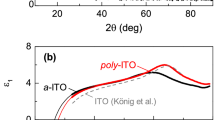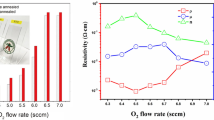Abstract
High transmittance and low resistivity make doped TiO2 films outstanding electrodes for use in optoelectronic devices operating in the infra-red region. In this work, we studied the impact of Ir doping in TiO2 thin films on the optoelectrical properties. High-quality nanocrystalline Ti1−x Ir x O2 thin films ~60 nm thick were grown by pulsed laser deposition from an Ir-doped target (x = 0–0.15 wt%). Films were deposited on quartz glass at a base pressure of 2 × 10−3 Pa and a substrate temperature of 780 K. The resistivity of the films decreased by 3 orders of magnitude when x increased from 0 to 0.10. The carrier mobility and concentrations increased by a factor of 2.55 from 18 to 46 cm2 V−1 s−1 at 5 %, and rose by ~2 orders of magnitude from 1019 to 1021 cm−3 at 15 % Ir, respectively. Optimal film properties were measured to be at x = 0.10, where resistivity, mobility, and carrier concentrations were 5 × 10−4 Ω cm, 32 cm2 V−1 s−1, and 1020 cm−3, respectively. The highest observed doping efficiency was ~1.1 which is similar to common dopants. At the same time, film transmittance was measured to be above 80 % in the visible and infrared regions, suitable for use in both spectral regimes. The films were characterized by X-ray diffraction, Hall transport, optical transmission, and Raman spectroscopy.





Similar content being viewed by others
References
Ellmer K (2012) Past achievements and future challenges in the development of optically transparent electrodes. Nat Photonics 6:809–817
Kim H, Gilmore CM, Pique A, Horwitz JS, Mattoussi H, Murata H, Kafafi ZH, Chrisey DB (1999) Electrical, optical, and structural properties of indium–tin–oxide thin films for organic light-emitting devices. J Appl Phys 86:6451
Jung D, Lee KH, Kim D, Burk D, Overzet LJ, Lee GS (2013) Highly conductive flexible multi-walled carbon nanotube sheet films for transparent touch screen. Jpn J Appl Phys 52:03BC03
Ginley DS, Bright C (2000) Transparent conducting oxides. MRS Bull 25:15–18
Kim H, Pique A, Horwitz JS, Murata H, Kafafi ZH, Gilmore CM, Chrisey DB (2000) Effect of aluminum doping on zinc oxide thin films grown by pulsed laser deposition for organic light-emitting devices. Thin Solid Films 377:798
Wang JT, Shi XL, Liu WW, Zhong XH, Wang JN, Pyrah L, Sanderson KD, Ramsey PM, Hirata M, Tsuri K (2014) Influence of preferred orientation on the electrical conductivity of fluorine-doped tin oxide films. Sci Rep 4:3679
Latthe SS, Liu S, Terashima C, Nakata K, Fujishima A (2014) Transparent, adherent, and photocatalytic SiO2–TiO2 coatings on polycarbonate for self-cleaning applications. Coatings 4:497
Sarah MSP, Musa MZ (2010) Electrical conductivity characteristics of TiO2 thin film. In: International conference on electronic devices, systems and applications (ICEDSA)
Lü X, Yang W, Quan Z, Lin T, Bai L, Wang L, Huang F, Zhao Y (2014) Enhanced electron transport in Nb-doped TiO2 nanoparticles via pressure-induced phase transitions. J Am Chem Soc 136:419–426
Neubert M, Cornelius S, Fiedler J, Gebel T, Liepack H, Kolitsch A, Vinnichenko M (2013) Overcoming challenges to the formation of high-quality polycrystalline TiO2: Ta transparent conducting films by magnetron sputtering. J Appl Phys 114:083707
Lozano O, Chen QY, Wadekar PV, Seo HW, Chinta PV, Chu LH, Tu LW, Lo I, Yeh SW, Ho NJ, Chuang FC, Jang DJ, Wijesundera D, Chu W-K (2013) Factors limiting the doping efficiency of transparent conductors: a case study of Nb-doped In2O3 epitaxial thin-films. Sol Energy Mater Sol Cells 113:171
Diouf B, Jeon WS, Pode R, Kwon JH (2012) Efficiency control in iridium complex-based phosphorescent light-emitting diodes. Adv Mater Sci Eng 2012. doi:10.1155/2012/794674
Eason R (2007) Pulsed laser deposition of thin films: applications-led growth of functional materials. Wiley, London, pp 245–247
Dabney MS, van Hest MFAM, Teplin CW, Arenkiel SP, Perkins JD, Ginley DS (2008) Pulsed laser deposited Nb Doped TiO2 as a transparent conducting oxide. Thin Solid Films 516:4133
Joint Committee on Powder Diffraction Standards (1967) Powder Diffraction File. ASTM, Philadelphia, PA, Card 21-1272–PDF
Joint Committee on Powder Diffraction Standards (1967) Powder Diffraction File. ASTM, Philadelphia, PA, Card 21-1276–PDF
Joint Committee on Powder Diffraction Standards (1988) Powder Diffraction File. International Centre for Diffraction Data, Swarthmore, Pennsylvania. Card 15-870–PDF
Hitosugi T, Yamada N, Nakao S, Hirose Y, Hasegawa T (2010) Properties of TiO2-based transparent conducting oxides. Phys Status Solidi A 207:1529
Kim H (2007) Pulsed laser deposition of thin films: applications-led growth of functional materials. Chapter 11. Transparent conducting oxide films. Wiley, London, pp 239–260
Perriere J, Millon E, Cracium V (2007) Pulsed laser deposition of thin films: applications-led growth of functional materials. Chapter 12. ZnO and ZnO-related compounds. Wiley, London, pp 261–289
Niemelä JP, Hirose Y, Hasegawa T, Karppinen M (2015) Transition in electron scattering mechanism in atomic layer deposited Nb:TiO2 thin films. Appl Phys Lett 106:042101
Meeks T, Krieger JB (1969) Temperature dependence of the resistivity of degenerately doped semiconductors at low temperatures. Phys Rev 185:1068–1072
Tang H, Prasad K, Sanjines R, Schmid PE, Levy F (1994) Electrical and optical properties of TiO2 anatase thin films. J Appl Phys 75:2042
Frischbier MV, Wardenga HF, Weidner M, Bierwagen O, Jia J, Shigesato Y, Klein A (2016) Influence of dopant species and concentration on grain boundary scattering in degenerately doped In2O3 thin films. Thin Solid Films. doi:10.1016/j.tsf.2016.03.022
Yamada N, Hitosugi T, Hoang NLH, Furubayashi Y, Hirose Y, Shimada T, Hasegawa T (2007) Fabrication of low resistivity Nb-doped TiO2 transparent conductive polycrystalline films on glass by reactive sputtering. Jpn J Appl Phys 46:5275
Jariwala D, Sangwan VK, Lauhon LJ, Marks TJ, Hersam MC (2013) Carbon nanomaterials for electronics, optoelectronics, photovoltaics, and sensing. Chem Soc Rev 42:2824–2860
Majumdar S, Mallik R, Sampathkumaran EV, Paulose PL (1998) Residual resistivity ratio and its relation to the positive magnetoresistance behavior in natural multilayer LaMn2Ge2; relevance to artificial multilayer physics. Solid State Commun 108:349–353
Paine DC, Whitson T, Janiac D, Beresford R, Yang CO, Lewis B (1999) A study of low temperature crystallization of amorphous thin film indium–tin–oxide. J Appl Phys 85:8445
Lee PA, Ramakrishnan TV (1985) Disordered electronic systems. Rev Mod Phys 57:287
Anthony PL, Arnold RG, Arroyo C, Bega K, Biesiada J, Bosted PE, Bower G, Cahoon J, Carr R, Cates GD, Chen J-P, Chudakov E, Cooke M, Decowski P, Deur A, Emam W, Erickson R, Fieguth T, Field C, Gao J, Gary M, Gustafsson K, Hicks RS, Holmes R, Hughes EW, Humensky TB, Jones GM, Kaufman LJ, Keller L, Kolomensky YuG, Kumar KS, LaViolette P, Lhuillier D, Lombard-Nelsen RM, Marshall Z, Mastromarino P, McKeown RD, Michaels R, Niedziela J, Olson M, Paschke KD, Peterson GA, Pitthan R, Relyea D, Rock SE, Saxton O, Singh J, Souder PA, Szalata ZM, Turner J, Tweedie B, Vacheret A, Walz D, Weber T, Weisend J, Woods M, Younus I (2005) Precision measurement of the weak mixing angle in Møller scattering. Phys Rev Lett 95:081601
Kawar RK, Chigare PS, Patil PS (2003) Substrate temperature dependent structural, optical and electrical properties of spray deposited iridium oxide thin films. Appl Surf Sci 206:90
Noh JP, Shimogishi F, Otsuka N (2003) Strong localization of carriers in δ-doped GaAs structures. Phys Rev B 67:075309
Khan M, Gul SR, Li J, Cao W (2015) Variations in the structural, electronic and optical properties of N-doped TiO2 with increasing N doping concentration. Mod Phys Lett B 29:1550022
Mendelsberg RJ, Garcia G, Milliron DJ (2012) Extracting reliable electronic properties from transmission spectra of indium tin oxide thin films and nanocrystal films by careful application of the drude theory. J Appl Phys 111:063515
Sato Y, Sanno Y, Tasaki C, Oka N, Kamiyama T, Shigesato Y (2010) Electrical and optical properties of Nb-doped TiO2 films deposited by DC magnetron sputtering using slightly reduced Nb-doped TiO2-x ceramic targets. J Vac Sci Technol, A 28:851
Kurita D, Ohta S, Sugiura K, Ohta H, Koumoto K (2006) Carrier generation and transport properties of heavily Nb-doped anatase TiO2 epitaxial films at high temperatures. J Appl Phys 100:096105
Vlcek M, Cızek J, Prochazka I, Novotny M, Bulır J, Lancok J, Anwand W, Brauer G, Mosnier JP (2014) Defect studies of thin ZnO films prepared by pulsed laser deposition. J Phys: Conf Ser 505:012021
Pankove JI (1975) Optical processes in semiconductors, 2nd edn. Dover Publishers, New York, p 35
Valencia S, Marín JM, Restrepo G (2010) Study of the bandgap of synthesized titanium dioxide nanoparticules using the Sol–Gel method and a hydrothermal treatment. Open Mater Sci J 4:9–14
Enright B, Fitzmaurice D (1996) Spectroscopic determination of electron and hole effective masses in a nanocrystalline semiconductor film. J Phys Chem 100:1027–1035
Kormann C, Bahnemann D, Hoffmann M (1988) Preparation and characterization of quantum-size titanium dioxide. J Phys Chem 92:5196
Jain SC, McGregor JM, Roulston DJ (1990) Band-gap narrowing in novel III–V semiconductors. J Appl Phys 68:3747
Kim CE, Moon P, Kim S, Myoung J-M, Jang HW, Bang J, Yun I (2010) Effect of carrier concentration on optical bandgap shift in ZnO: Ga thin films. Thin Solid Films 518:6304–6307
Dunnill CW, Aiken ZA, Kafizas A, Pratten J, Wilson M, Morgan DJ, Parkin IP (2009) White light induced photocatalytic activity of sulfur-doped TiO2 thin films and their potential for antibacterial application. J Mater Chem 19:8747
Mo Y, Stefan IC, Cai WB, Dong J, Carey P, Scherson DA (2002) In Situ Iridium LIII-Edge X-ray absorption and surface enhanced Raman spectroscopy of electrodeposited iridium oxide films in aqueous electrolytes. J Phys Chem B 106:3681–3686
Siedle AR, Newmark RA, Brown-Wensley KA, Skarjune RP, Haddad LC, Hodgson KO, Roe AL (1988) Solid-state organometallic chemistry of molecular metal oxide clusters: carbon-hydrogen activation by an iridium polyoxometalate. Organometallics 7:2078–2079
Hardcastle FD, Wachs IE (2005) Determination of molybdenum–oxygen bond distances and bond orders by Raman spectroscopy. J Raman Spectrosc 21:683–691
Adonin SA, Izarova NV, Besson C, Abramov PA, Santiago-Schübel B, Kögerler P, Fedin VP, Sokolov MN (2014) An IrIV-containing polyoxometalate. Chem Commun 51:1222
Gavartin JL, MuñozRamo D, Shluger AL, Bersuker G, Lee BH (2006) Negative oxygen vacancies in HfO2HfO2 as charge traps in high-kk stacks. Appl Phys Lett 89:082908
Weibel A, Bouchet R, Knauth P (2006) Electrical properties and defect chemistry of anatase (TiO2). Solid State Ionics 177:229–236
Acknowledgements
Authors would like to acknowledge Arthur W. Lichtenberger for the fruitful discussion and invaluable advice. Additional acknowledgements are extended to Michal Sabat and Keye Sun for help with experimental setup and film characterization.
Funding
This research was funded by the American Public Power Association, Demonstration of Energy & Efficiency Developments, Virginia Army National Guard, and the U.S. Army Research Laboratory under agreement number W911NF-14-2-0005 with Dr. Joe Labukas as project manager. The U.S. Government is authorized to reproduce and distribute reprints for Governmental purposes notwithstanding any copyright notation thereon.
Author information
Authors and Affiliations
Corresponding author
Ethics declarations
Conflict of interest
The authors declare that they have no conflict of interest.
Rights and permissions
About this article
Cite this article
Slonopas, A., Melia, M., Xie, K. et al. Factors limiting doping efficiency of Iridium in pulsed laser deposited TiO2 transparent conducting oxide. J Mater Sci 51, 8995–9004 (2016). https://doi.org/10.1007/s10853-016-0152-9
Received:
Accepted:
Published:
Issue Date:
DOI: https://doi.org/10.1007/s10853-016-0152-9




